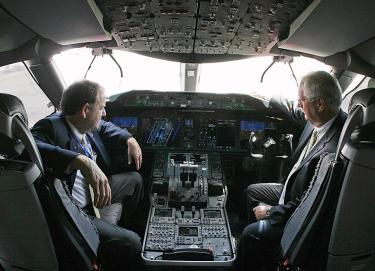Boeing says 787 woes should be in the past now
A top Boeing executive said the plane maker is frustrated with its latest 787 Dreamliner production glitch, but that it should not delay output goals.
Boeing vice president of development Mark Jenks said at a news conference yesterday in Singapore that the company has fixed a shimming problem discovered earlier this month on about 787 fuselages. Jenks said Boeing still plans to boost production from a current two to three 787s a month, to 10 of the planes a month by the end of next year. Jenks said the production mistake was “clearly frustrating and we’d rather it not happen.”
Boeing delivered its first Dreamliners last year to All Nippon Airways after several delays pushed back delivery by three years. ANA has so far received just two of the mid-sized, fuel-efficient jets, which is set to star at the Singapore Airshow this week where companies touting private jets and defense hardware to the Asian market will also be out in force.
With Europe mired in a debt crisis and the US economic recovery still gaining traction, the world’s aircraft makers, major defense contractors and aerospace companies are looking at Asia’s robust markets, analysts said. Singaporean Second Minister for Trade and Industry S. Iswaran said Asia will account for 29 percent of global aircraft deliveries by 2026 and 32 percent of world air traffic in 2028.
However, with several airlines having already announced major purchases during the past 18 months, a key area of interest at the airshow — which starts tomorrow and runs through Sunday — will be the growing market for private jets in a region with expanding ranks of super-rich. “I’m expecting more focus on the private jet market,” said Shukor Yusof, a Singapore-based aviation analyst at Standard & Poor’s Equity Research.
“I think makers like Bombardier, Gulfstream and Embraer have more to offer in terms of the growing private jet business in mainland China and parts of Southeast Asia,” he said. Shukor said Asian tycoons are increasingly drawn to the convenience of a private jets over commercial flights, especially in a geographically fragmented region. “It’s more than just a status symbol, it’s more for practicality ... It’s probably more economical as well,” he said.
Defense companies will also make their presence felt at the biennial show.
India recently said it prefers the Rafale, made by French firm Dassault Group, over the Eurofighter after an intense bidding process for 126 fighter jets in a contract estimated to be worth US$12 billion. It is the world’s biggest single defense deal currently in process and underscores the region’s potential as a lucrative defense market.
“I think we can describe the picture in the Asia-Pacific market as an arms race,” said Guy Anderson, chief analyst at Jane’s Defence Industry. “We have a combination of growing national wealth, emerging national resources and the need to protect growth,” he said. “The rise of China remains a factor, but there are also numerous lower level regional rivalries ... Countries typically seek to achieve parity with their regional peers.”
For the first time, a Land Defense Expo will be launched in conjunction with the Singapore Airshow, organizers said. Consultancy Frost and Sullivan estimates the Asia-Pacific market for land defense systems should reach US$9.4 billion by 2016, up from US$5.4 billion in 2009.
The shift by regional armed forces toward weapons centered on high-tech networks, including the use of drones, is among the drivers for military modernization program, according to analysts.
Source:AP and AFP, SINGAPORE

No comments:
Post a Comment